Ethical Issues in Fall Prevention: Risks, Rights, and Utilitarianism
VerifiedAdded on 2022/09/26
|10
|2686
|48
Report
AI Summary
This report addresses the ethical issues surrounding fall prevention, particularly for elderly and disabled patients. It explores the challenges nurses face in balancing patient independence with safety, considering factors such as weak muscles, poor vision, and medication side effects. The report examines the importance of patient independence, risk assessment, and the role of utilitarianism in decision-making. It highlights ethical dilemmas related to patient care, team communication, and human rights, including the use of restraints and the impact of organizational policies. The report also discusses the ethical code of conduct in fall risk and safety, drawing comparisons between India and Ireland, and emphasizes the importance of respecting patient rights while managing risks. Additionally, the report covers risk prevention measures, including staff training, data collection, and environmental modifications. The report concludes by emphasizing the necessity for nurses to maintain ethical standards and promote patient well-being through careful consideration of risks and rights.
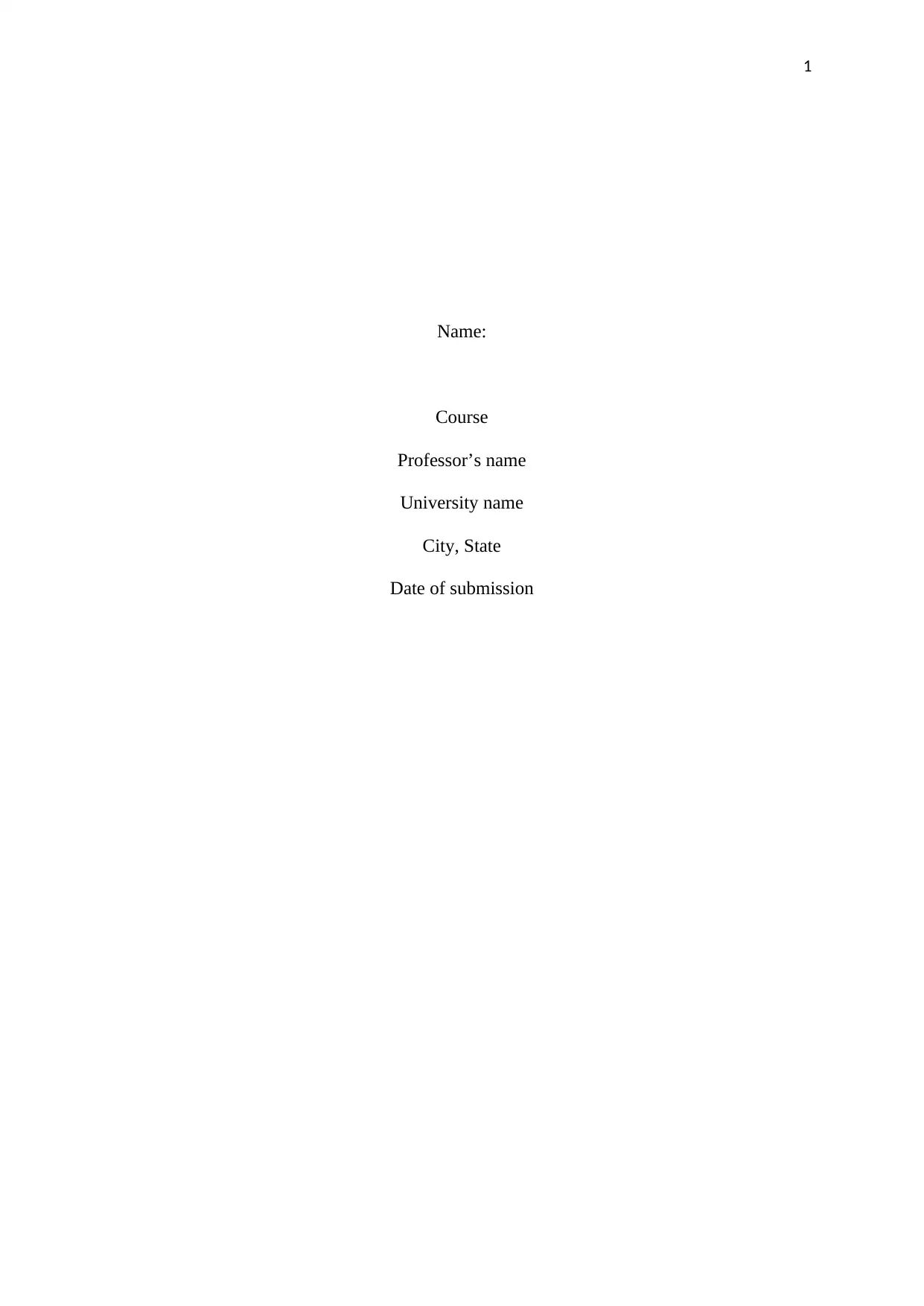
1
Name:
Course
Professor’s name
University name
City, State
Date of submission
Name:
Course
Professor’s name
University name
City, State
Date of submission
Paraphrase This Document
Need a fresh take? Get an instant paraphrase of this document with our AI Paraphraser
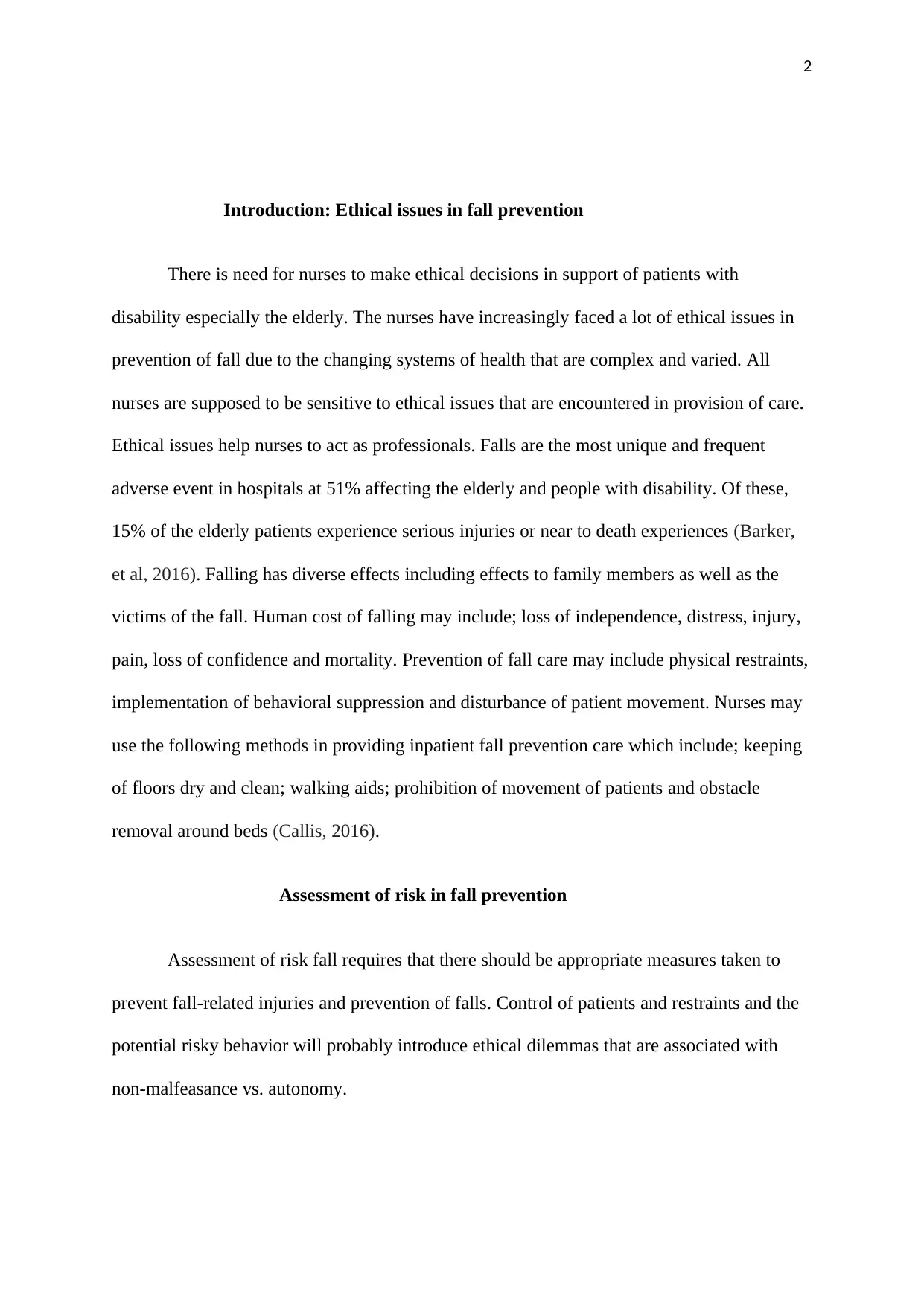
2
Introduction: Ethical issues in fall prevention
There is need for nurses to make ethical decisions in support of patients with
disability especially the elderly. The nurses have increasingly faced a lot of ethical issues in
prevention of fall due to the changing systems of health that are complex and varied. All
nurses are supposed to be sensitive to ethical issues that are encountered in provision of care.
Ethical issues help nurses to act as professionals. Falls are the most unique and frequent
adverse event in hospitals at 51% affecting the elderly and people with disability. Of these,
15% of the elderly patients experience serious injuries or near to death experiences (Barker,
et al, 2016). Falling has diverse effects including effects to family members as well as the
victims of the fall. Human cost of falling may include; loss of independence, distress, injury,
pain, loss of confidence and mortality. Prevention of fall care may include physical restraints,
implementation of behavioral suppression and disturbance of patient movement. Nurses may
use the following methods in providing inpatient fall prevention care which include; keeping
of floors dry and clean; walking aids; prohibition of movement of patients and obstacle
removal around beds (Callis, 2016).
Assessment of risk in fall prevention
Assessment of risk fall requires that there should be appropriate measures taken to
prevent fall-related injuries and prevention of falls. Control of patients and restraints and the
potential risky behavior will probably introduce ethical dilemmas that are associated with
non-malfeasance vs. autonomy.
Introduction: Ethical issues in fall prevention
There is need for nurses to make ethical decisions in support of patients with
disability especially the elderly. The nurses have increasingly faced a lot of ethical issues in
prevention of fall due to the changing systems of health that are complex and varied. All
nurses are supposed to be sensitive to ethical issues that are encountered in provision of care.
Ethical issues help nurses to act as professionals. Falls are the most unique and frequent
adverse event in hospitals at 51% affecting the elderly and people with disability. Of these,
15% of the elderly patients experience serious injuries or near to death experiences (Barker,
et al, 2016). Falling has diverse effects including effects to family members as well as the
victims of the fall. Human cost of falling may include; loss of independence, distress, injury,
pain, loss of confidence and mortality. Prevention of fall care may include physical restraints,
implementation of behavioral suppression and disturbance of patient movement. Nurses may
use the following methods in providing inpatient fall prevention care which include; keeping
of floors dry and clean; walking aids; prohibition of movement of patients and obstacle
removal around beds (Callis, 2016).
Assessment of risk in fall prevention
Assessment of risk fall requires that there should be appropriate measures taken to
prevent fall-related injuries and prevention of falls. Control of patients and restraints and the
potential risky behavior will probably introduce ethical dilemmas that are associated with
non-malfeasance vs. autonomy.
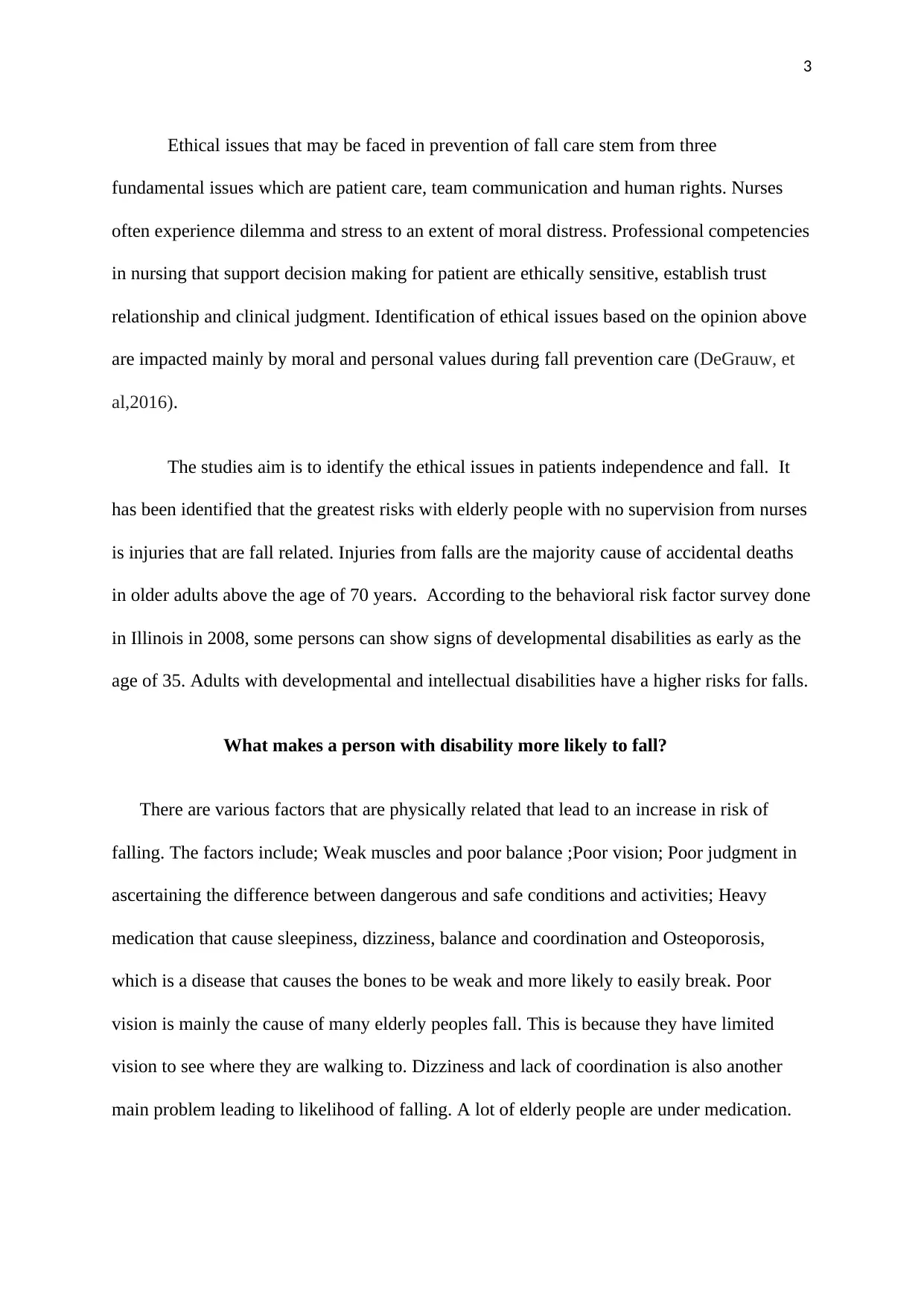
3
Ethical issues that may be faced in prevention of fall care stem from three
fundamental issues which are patient care, team communication and human rights. Nurses
often experience dilemma and stress to an extent of moral distress. Professional competencies
in nursing that support decision making for patient are ethically sensitive, establish trust
relationship and clinical judgment. Identification of ethical issues based on the opinion above
are impacted mainly by moral and personal values during fall prevention care (DeGrauw, et
al,2016).
The studies aim is to identify the ethical issues in patients independence and fall. It
has been identified that the greatest risks with elderly people with no supervision from nurses
is injuries that are fall related. Injuries from falls are the majority cause of accidental deaths
in older adults above the age of 70 years. According to the behavioral risk factor survey done
in Illinois in 2008, some persons can show signs of developmental disabilities as early as the
age of 35. Adults with developmental and intellectual disabilities have a higher risks for falls.
What makes a person with disability more likely to fall?
There are various factors that are physically related that lead to an increase in risk of
falling. The factors include; Weak muscles and poor balance ;Poor vision; Poor judgment in
ascertaining the difference between dangerous and safe conditions and activities; Heavy
medication that cause sleepiness, dizziness, balance and coordination and Osteoporosis,
which is a disease that causes the bones to be weak and more likely to easily break. Poor
vision is mainly the cause of many elderly peoples fall. This is because they have limited
vision to see where they are walking to. Dizziness and lack of coordination is also another
main problem leading to likelihood of falling. A lot of elderly people are under medication.
Ethical issues that may be faced in prevention of fall care stem from three
fundamental issues which are patient care, team communication and human rights. Nurses
often experience dilemma and stress to an extent of moral distress. Professional competencies
in nursing that support decision making for patient are ethically sensitive, establish trust
relationship and clinical judgment. Identification of ethical issues based on the opinion above
are impacted mainly by moral and personal values during fall prevention care (DeGrauw, et
al,2016).
The studies aim is to identify the ethical issues in patients independence and fall. It
has been identified that the greatest risks with elderly people with no supervision from nurses
is injuries that are fall related. Injuries from falls are the majority cause of accidental deaths
in older adults above the age of 70 years. According to the behavioral risk factor survey done
in Illinois in 2008, some persons can show signs of developmental disabilities as early as the
age of 35. Adults with developmental and intellectual disabilities have a higher risks for falls.
What makes a person with disability more likely to fall?
There are various factors that are physically related that lead to an increase in risk of
falling. The factors include; Weak muscles and poor balance ;Poor vision; Poor judgment in
ascertaining the difference between dangerous and safe conditions and activities; Heavy
medication that cause sleepiness, dizziness, balance and coordination and Osteoporosis,
which is a disease that causes the bones to be weak and more likely to easily break. Poor
vision is mainly the cause of many elderly peoples fall. This is because they have limited
vision to see where they are walking to. Dizziness and lack of coordination is also another
main problem leading to likelihood of falling. A lot of elderly people are under medication.
⊘ This is a preview!⊘
Do you want full access?
Subscribe today to unlock all pages.

Trusted by 1+ million students worldwide
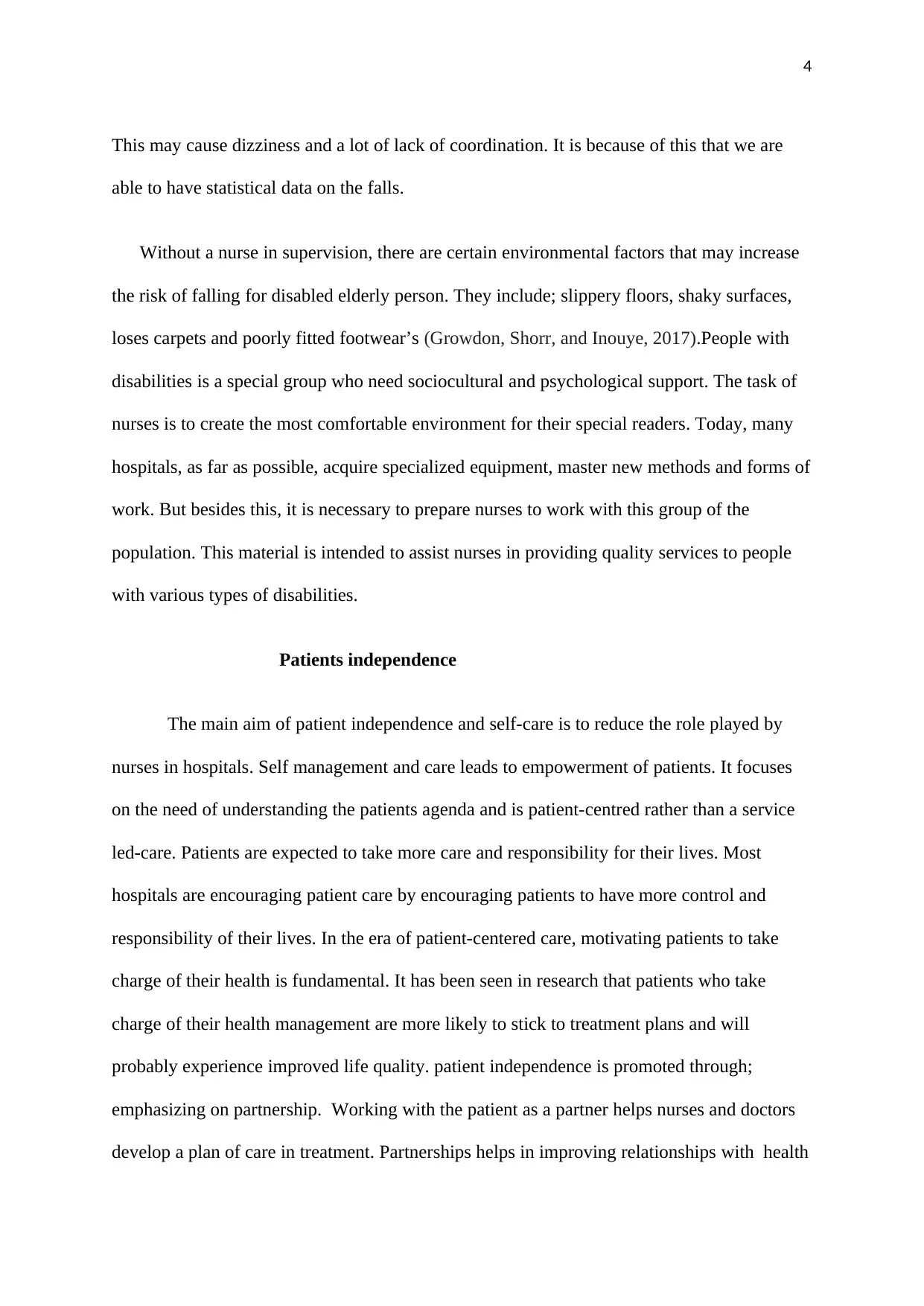
4
This may cause dizziness and a lot of lack of coordination. It is because of this that we are
able to have statistical data on the falls.
Without a nurse in supervision, there are certain environmental factors that may increase
the risk of falling for disabled elderly person. They include; slippery floors, shaky surfaces,
loses carpets and poorly fitted footwear’s (Growdon, Shorr, and Inouye, 2017).People with
disabilities is a special group who need sociocultural and psychological support. The task of
nurses is to create the most comfortable environment for their special readers. Today, many
hospitals, as far as possible, acquire specialized equipment, master new methods and forms of
work. But besides this, it is necessary to prepare nurses to work with this group of the
population. This material is intended to assist nurses in providing quality services to people
with various types of disabilities.
Patients independence
The main aim of patient independence and self-care is to reduce the role played by
nurses in hospitals. Self management and care leads to empowerment of patients. It focuses
on the need of understanding the patients agenda and is patient-centred rather than a service
led-care. Patients are expected to take more care and responsibility for their lives. Most
hospitals are encouraging patient care by encouraging patients to have more control and
responsibility of their lives. In the era of patient-centered care, motivating patients to take
charge of their health is fundamental. It has been seen in research that patients who take
charge of their health management are more likely to stick to treatment plans and will
probably experience improved life quality. patient independence is promoted through;
emphasizing on partnership. Working with the patient as a partner helps nurses and doctors
develop a plan of care in treatment. Partnerships helps in improving relationships with health
This may cause dizziness and a lot of lack of coordination. It is because of this that we are
able to have statistical data on the falls.
Without a nurse in supervision, there are certain environmental factors that may increase
the risk of falling for disabled elderly person. They include; slippery floors, shaky surfaces,
loses carpets and poorly fitted footwear’s (Growdon, Shorr, and Inouye, 2017).People with
disabilities is a special group who need sociocultural and psychological support. The task of
nurses is to create the most comfortable environment for their special readers. Today, many
hospitals, as far as possible, acquire specialized equipment, master new methods and forms of
work. But besides this, it is necessary to prepare nurses to work with this group of the
population. This material is intended to assist nurses in providing quality services to people
with various types of disabilities.
Patients independence
The main aim of patient independence and self-care is to reduce the role played by
nurses in hospitals. Self management and care leads to empowerment of patients. It focuses
on the need of understanding the patients agenda and is patient-centred rather than a service
led-care. Patients are expected to take more care and responsibility for their lives. Most
hospitals are encouraging patient care by encouraging patients to have more control and
responsibility of their lives. In the era of patient-centered care, motivating patients to take
charge of their health is fundamental. It has been seen in research that patients who take
charge of their health management are more likely to stick to treatment plans and will
probably experience improved life quality. patient independence is promoted through;
emphasizing on partnership. Working with the patient as a partner helps nurses and doctors
develop a plan of care in treatment. Partnerships helps in improving relationships with health
Paraphrase This Document
Need a fresh take? Get an instant paraphrase of this document with our AI Paraphraser
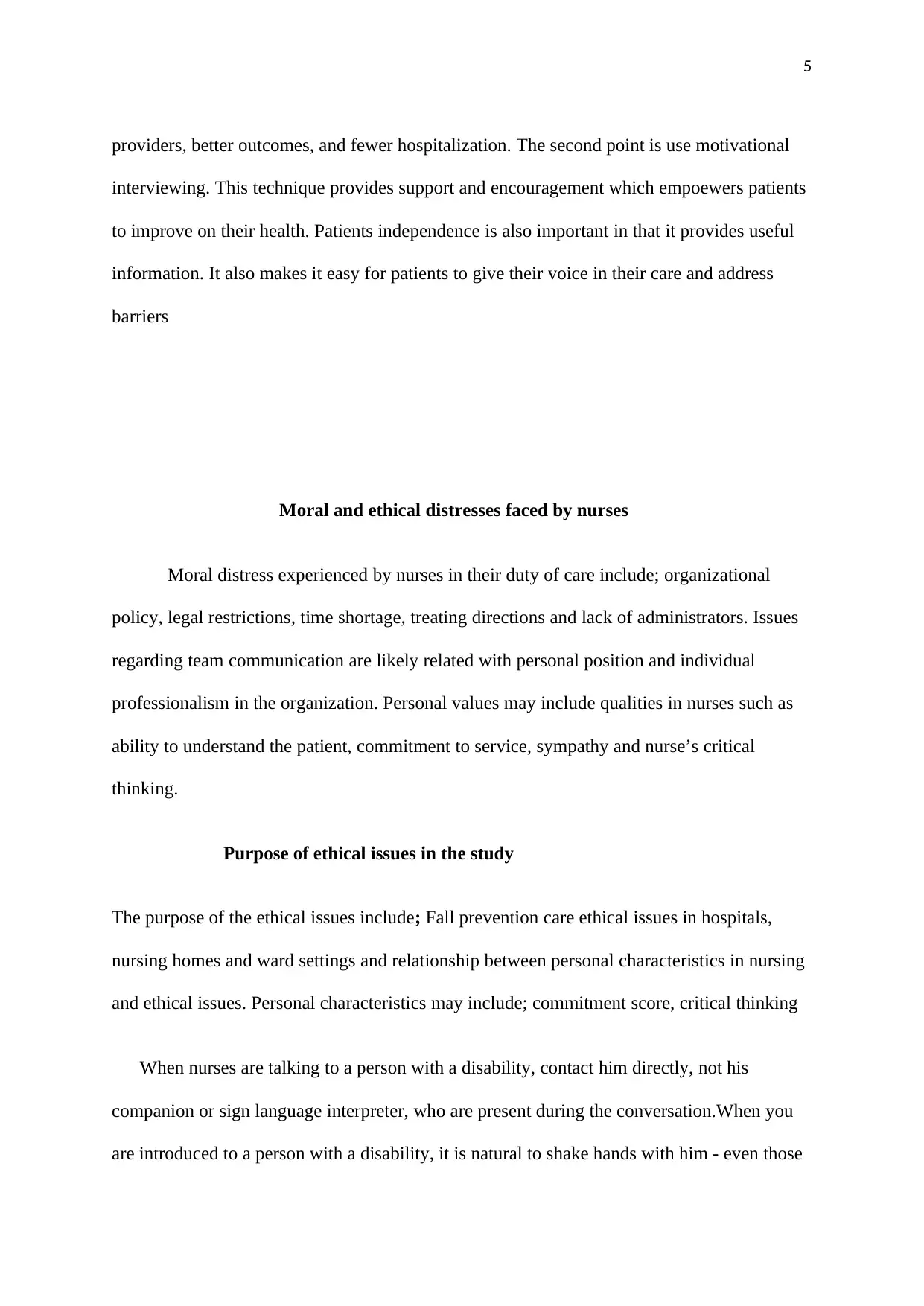
5
providers, better outcomes, and fewer hospitalization. The second point is use motivational
interviewing. This technique provides support and encouragement which empoewers patients
to improve on their health. Patients independence is also important in that it provides useful
information. It also makes it easy for patients to give their voice in their care and address
barriers
Moral and ethical distresses faced by nurses
Moral distress experienced by nurses in their duty of care include; organizational
policy, legal restrictions, time shortage, treating directions and lack of administrators. Issues
regarding team communication are likely related with personal position and individual
professionalism in the organization. Personal values may include qualities in nurses such as
ability to understand the patient, commitment to service, sympathy and nurse’s critical
thinking.
Purpose of ethical issues in the study
The purpose of the ethical issues include; Fall prevention care ethical issues in hospitals,
nursing homes and ward settings and relationship between personal characteristics in nursing
and ethical issues. Personal characteristics may include; commitment score, critical thinking
When nurses are talking to a person with a disability, contact him directly, not his
companion or sign language interpreter, who are present during the conversation.When you
are introduced to a person with a disability, it is natural to shake hands with him - even those
providers, better outcomes, and fewer hospitalization. The second point is use motivational
interviewing. This technique provides support and encouragement which empoewers patients
to improve on their health. Patients independence is also important in that it provides useful
information. It also makes it easy for patients to give their voice in their care and address
barriers
Moral and ethical distresses faced by nurses
Moral distress experienced by nurses in their duty of care include; organizational
policy, legal restrictions, time shortage, treating directions and lack of administrators. Issues
regarding team communication are likely related with personal position and individual
professionalism in the organization. Personal values may include qualities in nurses such as
ability to understand the patient, commitment to service, sympathy and nurse’s critical
thinking.
Purpose of ethical issues in the study
The purpose of the ethical issues include; Fall prevention care ethical issues in hospitals,
nursing homes and ward settings and relationship between personal characteristics in nursing
and ethical issues. Personal characteristics may include; commitment score, critical thinking
When nurses are talking to a person with a disability, contact him directly, not his
companion or sign language interpreter, who are present during the conversation.When you
are introduced to a person with a disability, it is natural to shake hands with him - even those
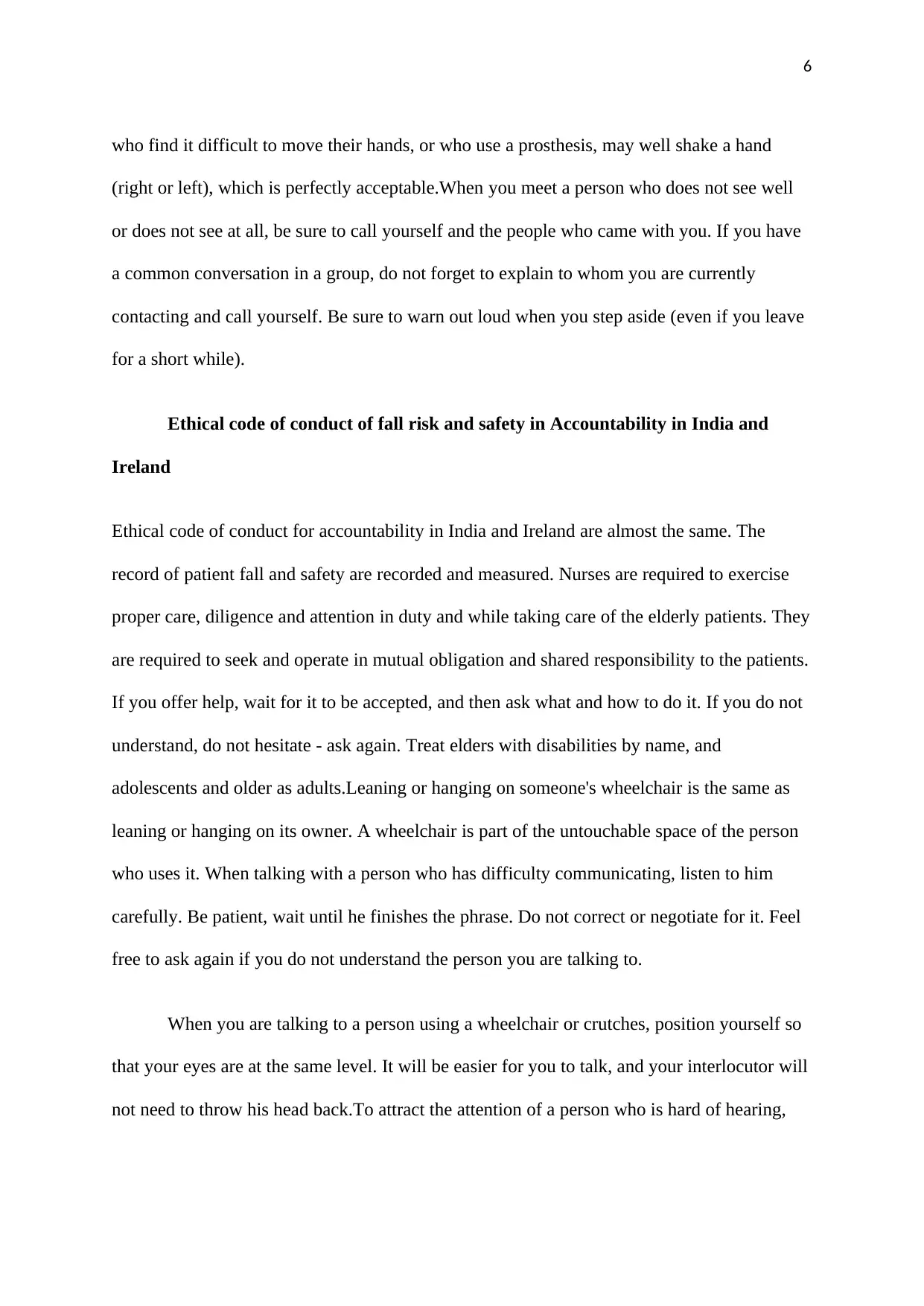
6
who find it difficult to move their hands, or who use a prosthesis, may well shake a hand
(right or left), which is perfectly acceptable.When you meet a person who does not see well
or does not see at all, be sure to call yourself and the people who came with you. If you have
a common conversation in a group, do not forget to explain to whom you are currently
contacting and call yourself. Be sure to warn out loud when you step aside (even if you leave
for a short while).
Ethical code of conduct of fall risk and safety in Accountability in India and
Ireland
Ethical code of conduct for accountability in India and Ireland are almost the same. The
record of patient fall and safety are recorded and measured. Nurses are required to exercise
proper care, diligence and attention in duty and while taking care of the elderly patients. They
are required to seek and operate in mutual obligation and shared responsibility to the patients.
If you offer help, wait for it to be accepted, and then ask what and how to do it. If you do not
understand, do not hesitate - ask again. Treat elders with disabilities by name, and
adolescents and older as adults.Leaning or hanging on someone's wheelchair is the same as
leaning or hanging on its owner. A wheelchair is part of the untouchable space of the person
who uses it. When talking with a person who has difficulty communicating, listen to him
carefully. Be patient, wait until he finishes the phrase. Do not correct or negotiate for it. Feel
free to ask again if you do not understand the person you are talking to.
When you are talking to a person using a wheelchair or crutches, position yourself so
that your eyes are at the same level. It will be easier for you to talk, and your interlocutor will
not need to throw his head back.To attract the attention of a person who is hard of hearing,
who find it difficult to move their hands, or who use a prosthesis, may well shake a hand
(right or left), which is perfectly acceptable.When you meet a person who does not see well
or does not see at all, be sure to call yourself and the people who came with you. If you have
a common conversation in a group, do not forget to explain to whom you are currently
contacting and call yourself. Be sure to warn out loud when you step aside (even if you leave
for a short while).
Ethical code of conduct of fall risk and safety in Accountability in India and
Ireland
Ethical code of conduct for accountability in India and Ireland are almost the same. The
record of patient fall and safety are recorded and measured. Nurses are required to exercise
proper care, diligence and attention in duty and while taking care of the elderly patients. They
are required to seek and operate in mutual obligation and shared responsibility to the patients.
If you offer help, wait for it to be accepted, and then ask what and how to do it. If you do not
understand, do not hesitate - ask again. Treat elders with disabilities by name, and
adolescents and older as adults.Leaning or hanging on someone's wheelchair is the same as
leaning or hanging on its owner. A wheelchair is part of the untouchable space of the person
who uses it. When talking with a person who has difficulty communicating, listen to him
carefully. Be patient, wait until he finishes the phrase. Do not correct or negotiate for it. Feel
free to ask again if you do not understand the person you are talking to.
When you are talking to a person using a wheelchair or crutches, position yourself so
that your eyes are at the same level. It will be easier for you to talk, and your interlocutor will
not need to throw his head back.To attract the attention of a person who is hard of hearing,
⊘ This is a preview!⊘
Do you want full access?
Subscribe today to unlock all pages.

Trusted by 1+ million students worldwide
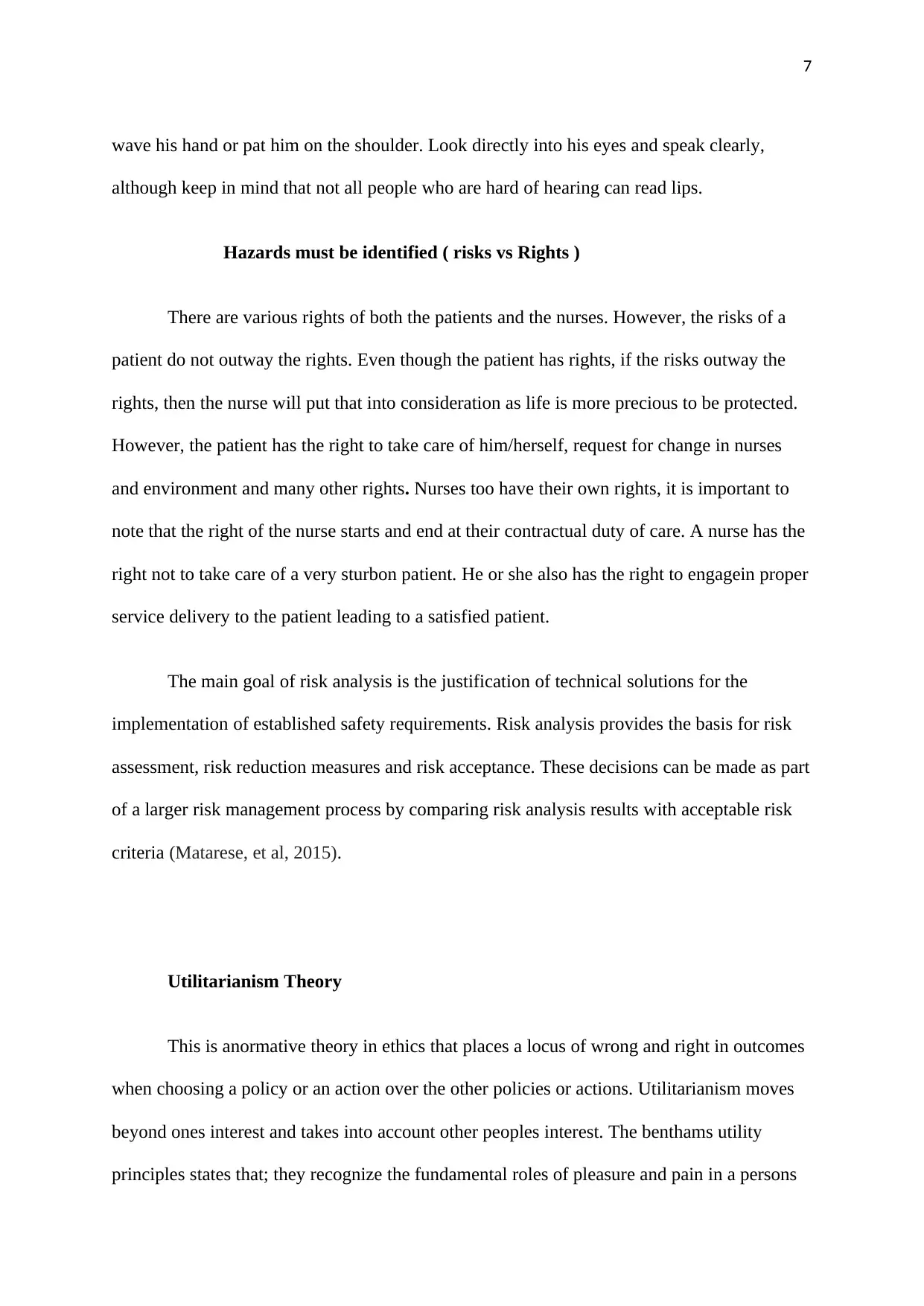
7
wave his hand or pat him on the shoulder. Look directly into his eyes and speak clearly,
although keep in mind that not all people who are hard of hearing can read lips.
Hazards must be identified ( risks vs Rights )
There are various rights of both the patients and the nurses. However, the risks of a
patient do not outway the rights. Even though the patient has rights, if the risks outway the
rights, then the nurse will put that into consideration as life is more precious to be protected.
However, the patient has the right to take care of him/herself, request for change in nurses
and environment and many other rights. Nurses too have their own rights, it is important to
note that the right of the nurse starts and end at their contractual duty of care. A nurse has the
right not to take care of a very sturbon patient. He or she also has the right to engagein proper
service delivery to the patient leading to a satisfied patient.
The main goal of risk analysis is the justification of technical solutions for the
implementation of established safety requirements. Risk analysis provides the basis for risk
assessment, risk reduction measures and risk acceptance. These decisions can be made as part
of a larger risk management process by comparing risk analysis results with acceptable risk
criteria (Matarese, et al, 2015).
Utilitarianism Theory
This is anormative theory in ethics that places a locus of wrong and right in outcomes
when choosing a policy or an action over the other policies or actions. Utilitarianism moves
beyond ones interest and takes into account other peoples interest. The benthams utility
principles states that; they recognize the fundamental roles of pleasure and pain in a persons
wave his hand or pat him on the shoulder. Look directly into his eyes and speak clearly,
although keep in mind that not all people who are hard of hearing can read lips.
Hazards must be identified ( risks vs Rights )
There are various rights of both the patients and the nurses. However, the risks of a
patient do not outway the rights. Even though the patient has rights, if the risks outway the
rights, then the nurse will put that into consideration as life is more precious to be protected.
However, the patient has the right to take care of him/herself, request for change in nurses
and environment and many other rights. Nurses too have their own rights, it is important to
note that the right of the nurse starts and end at their contractual duty of care. A nurse has the
right not to take care of a very sturbon patient. He or she also has the right to engagein proper
service delivery to the patient leading to a satisfied patient.
The main goal of risk analysis is the justification of technical solutions for the
implementation of established safety requirements. Risk analysis provides the basis for risk
assessment, risk reduction measures and risk acceptance. These decisions can be made as part
of a larger risk management process by comparing risk analysis results with acceptable risk
criteria (Matarese, et al, 2015).
Utilitarianism Theory
This is anormative theory in ethics that places a locus of wrong and right in outcomes
when choosing a policy or an action over the other policies or actions. Utilitarianism moves
beyond ones interest and takes into account other peoples interest. The benthams utility
principles states that; they recognize the fundamental roles of pleasure and pain in a persons
Paraphrase This Document
Need a fresh take? Get an instant paraphrase of this document with our AI Paraphraser
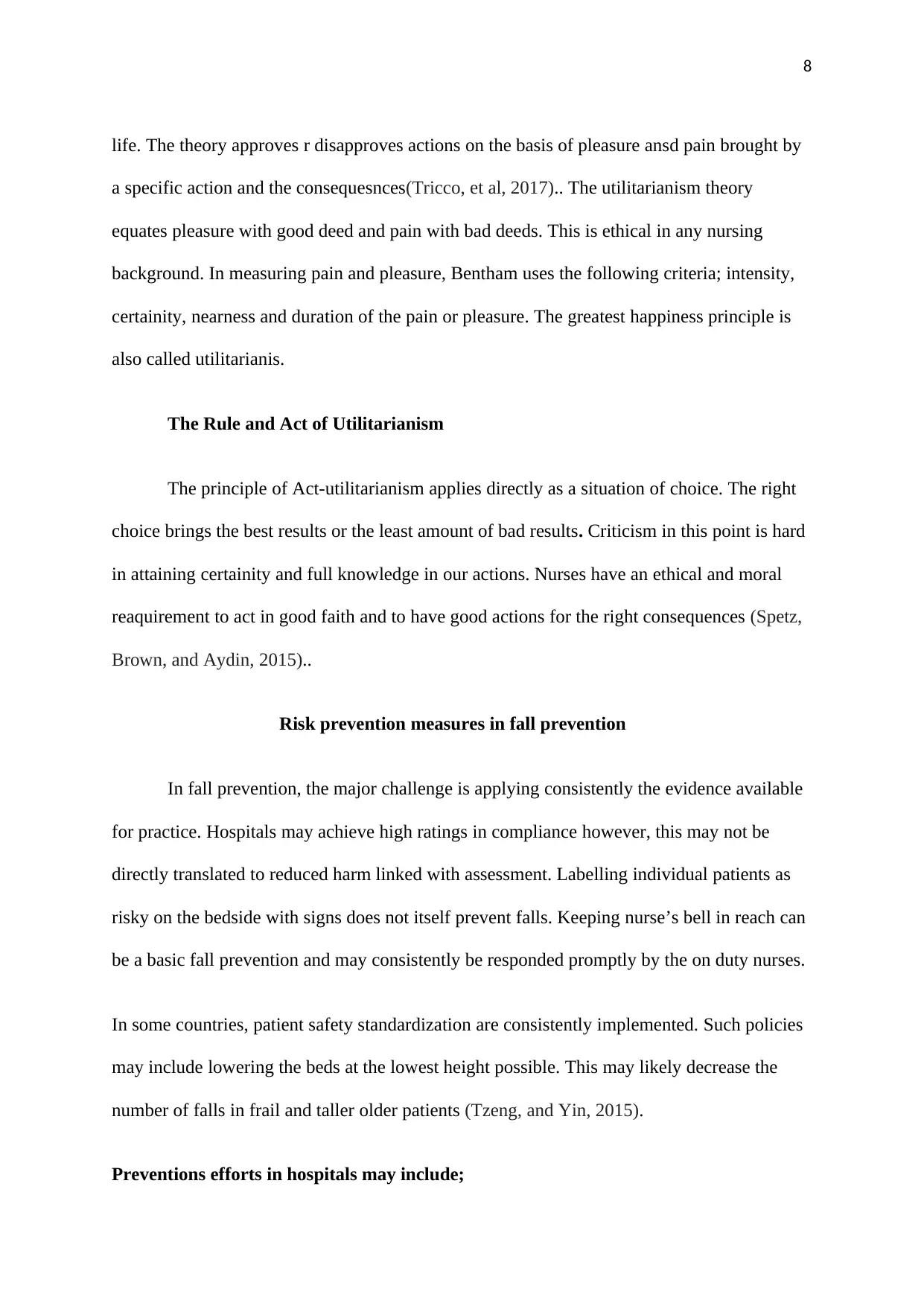
8
life. The theory approves r disapproves actions on the basis of pleasure ansd pain brought by
a specific action and the consequesnces(Tricco, et al, 2017).. The utilitarianism theory
equates pleasure with good deed and pain with bad deeds. This is ethical in any nursing
background. In measuring pain and pleasure, Bentham uses the following criteria; intensity,
certainity, nearness and duration of the pain or pleasure. The greatest happiness principle is
also called utilitarianis.
The Rule and Act of Utilitarianism
The principle of Act-utilitarianism applies directly as a situation of choice. The right
choice brings the best results or the least amount of bad results. Criticism in this point is hard
in attaining certainity and full knowledge in our actions. Nurses have an ethical and moral
reaquirement to act in good faith and to have good actions for the right consequences (Spetz,
Brown, and Aydin, 2015)..
Risk prevention measures in fall prevention
In fall prevention, the major challenge is applying consistently the evidence available
for practice. Hospitals may achieve high ratings in compliance however, this may not be
directly translated to reduced harm linked with assessment. Labelling individual patients as
risky on the bedside with signs does not itself prevent falls. Keeping nurse’s bell in reach can
be a basic fall prevention and may consistently be responded promptly by the on duty nurses.
In some countries, patient safety standardization are consistently implemented. Such policies
may include lowering the beds at the lowest height possible. This may likely decrease the
number of falls in frail and taller older patients (Tzeng, and Yin, 2015).
Preventions efforts in hospitals may include;
life. The theory approves r disapproves actions on the basis of pleasure ansd pain brought by
a specific action and the consequesnces(Tricco, et al, 2017).. The utilitarianism theory
equates pleasure with good deed and pain with bad deeds. This is ethical in any nursing
background. In measuring pain and pleasure, Bentham uses the following criteria; intensity,
certainity, nearness and duration of the pain or pleasure. The greatest happiness principle is
also called utilitarianis.
The Rule and Act of Utilitarianism
The principle of Act-utilitarianism applies directly as a situation of choice. The right
choice brings the best results or the least amount of bad results. Criticism in this point is hard
in attaining certainity and full knowledge in our actions. Nurses have an ethical and moral
reaquirement to act in good faith and to have good actions for the right consequences (Spetz,
Brown, and Aydin, 2015)..
Risk prevention measures in fall prevention
In fall prevention, the major challenge is applying consistently the evidence available
for practice. Hospitals may achieve high ratings in compliance however, this may not be
directly translated to reduced harm linked with assessment. Labelling individual patients as
risky on the bedside with signs does not itself prevent falls. Keeping nurse’s bell in reach can
be a basic fall prevention and may consistently be responded promptly by the on duty nurses.
In some countries, patient safety standardization are consistently implemented. Such policies
may include lowering the beds at the lowest height possible. This may likely decrease the
number of falls in frail and taller older patients (Tzeng, and Yin, 2015).
Preventions efforts in hospitals may include;
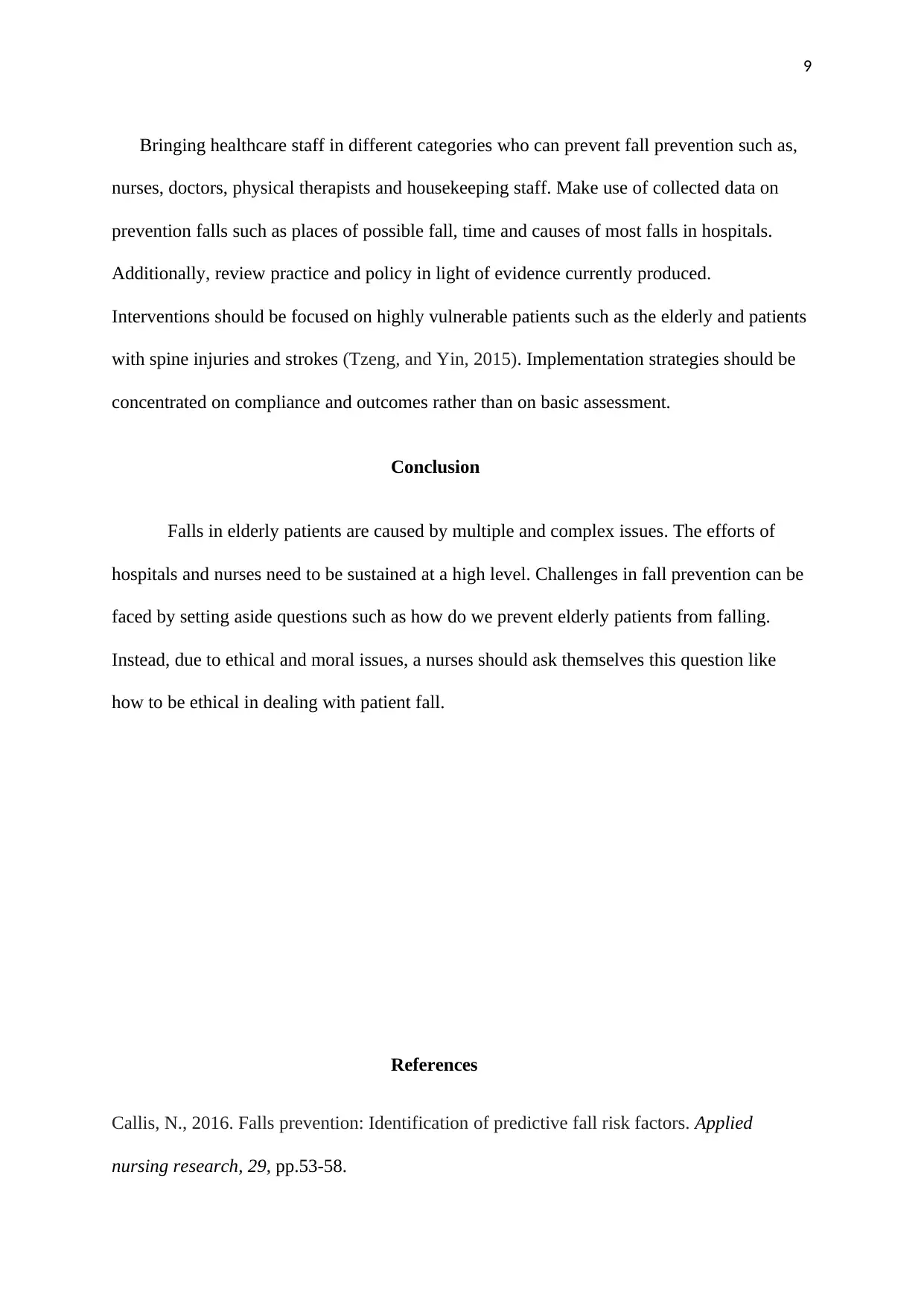
9
Bringing healthcare staff in different categories who can prevent fall prevention such as,
nurses, doctors, physical therapists and housekeeping staff. Make use of collected data on
prevention falls such as places of possible fall, time and causes of most falls in hospitals.
Additionally, review practice and policy in light of evidence currently produced.
Interventions should be focused on highly vulnerable patients such as the elderly and patients
with spine injuries and strokes (Tzeng, and Yin, 2015). Implementation strategies should be
concentrated on compliance and outcomes rather than on basic assessment.
Conclusion
Falls in elderly patients are caused by multiple and complex issues. The efforts of
hospitals and nurses need to be sustained at a high level. Challenges in fall prevention can be
faced by setting aside questions such as how do we prevent elderly patients from falling.
Instead, due to ethical and moral issues, a nurses should ask themselves this question like
how to be ethical in dealing with patient fall.
References
Callis, N., 2016. Falls prevention: Identification of predictive fall risk factors. Applied
nursing research, 29, pp.53-58.
Bringing healthcare staff in different categories who can prevent fall prevention such as,
nurses, doctors, physical therapists and housekeeping staff. Make use of collected data on
prevention falls such as places of possible fall, time and causes of most falls in hospitals.
Additionally, review practice and policy in light of evidence currently produced.
Interventions should be focused on highly vulnerable patients such as the elderly and patients
with spine injuries and strokes (Tzeng, and Yin, 2015). Implementation strategies should be
concentrated on compliance and outcomes rather than on basic assessment.
Conclusion
Falls in elderly patients are caused by multiple and complex issues. The efforts of
hospitals and nurses need to be sustained at a high level. Challenges in fall prevention can be
faced by setting aside questions such as how do we prevent elderly patients from falling.
Instead, due to ethical and moral issues, a nurses should ask themselves this question like
how to be ethical in dealing with patient fall.
References
Callis, N., 2016. Falls prevention: Identification of predictive fall risk factors. Applied
nursing research, 29, pp.53-58.
⊘ This is a preview!⊘
Do you want full access?
Subscribe today to unlock all pages.

Trusted by 1+ million students worldwide
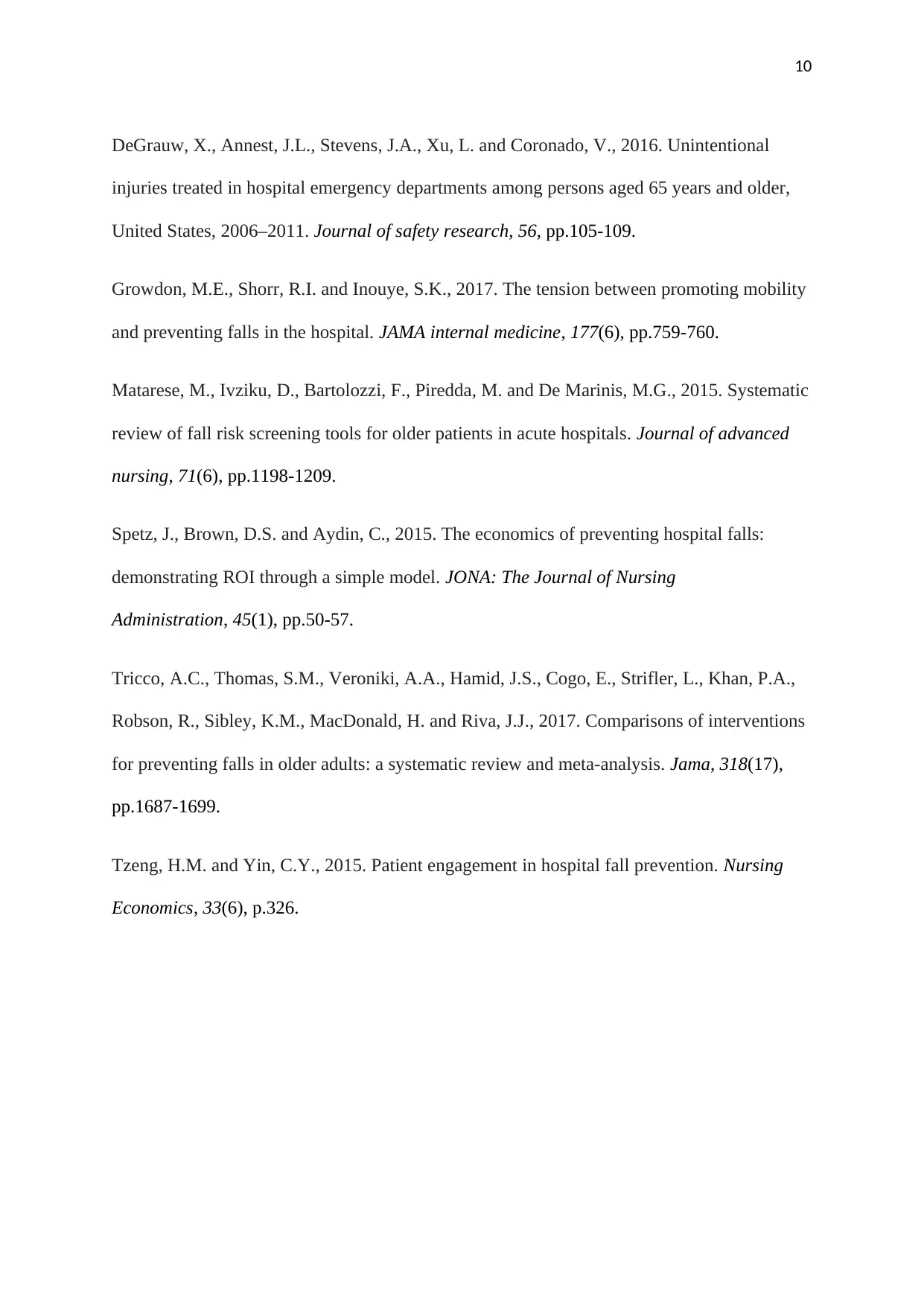
10
DeGrauw, X., Annest, J.L., Stevens, J.A., Xu, L. and Coronado, V., 2016. Unintentional
injuries treated in hospital emergency departments among persons aged 65 years and older,
United States, 2006–2011. Journal of safety research, 56, pp.105-109.
Growdon, M.E., Shorr, R.I. and Inouye, S.K., 2017. The tension between promoting mobility
and preventing falls in the hospital. JAMA internal medicine, 177(6), pp.759-760.
Matarese, M., Ivziku, D., Bartolozzi, F., Piredda, M. and De Marinis, M.G., 2015. Systematic
review of fall risk screening tools for older patients in acute hospitals. Journal of advanced
nursing, 71(6), pp.1198-1209.
Spetz, J., Brown, D.S. and Aydin, C., 2015. The economics of preventing hospital falls:
demonstrating ROI through a simple model. JONA: The Journal of Nursing
Administration, 45(1), pp.50-57.
Tricco, A.C., Thomas, S.M., Veroniki, A.A., Hamid, J.S., Cogo, E., Strifler, L., Khan, P.A.,
Robson, R., Sibley, K.M., MacDonald, H. and Riva, J.J., 2017. Comparisons of interventions
for preventing falls in older adults: a systematic review and meta-analysis. Jama, 318(17),
pp.1687-1699.
Tzeng, H.M. and Yin, C.Y., 2015. Patient engagement in hospital fall prevention. Nursing
Economics, 33(6), p.326.
DeGrauw, X., Annest, J.L., Stevens, J.A., Xu, L. and Coronado, V., 2016. Unintentional
injuries treated in hospital emergency departments among persons aged 65 years and older,
United States, 2006–2011. Journal of safety research, 56, pp.105-109.
Growdon, M.E., Shorr, R.I. and Inouye, S.K., 2017. The tension between promoting mobility
and preventing falls in the hospital. JAMA internal medicine, 177(6), pp.759-760.
Matarese, M., Ivziku, D., Bartolozzi, F., Piredda, M. and De Marinis, M.G., 2015. Systematic
review of fall risk screening tools for older patients in acute hospitals. Journal of advanced
nursing, 71(6), pp.1198-1209.
Spetz, J., Brown, D.S. and Aydin, C., 2015. The economics of preventing hospital falls:
demonstrating ROI through a simple model. JONA: The Journal of Nursing
Administration, 45(1), pp.50-57.
Tricco, A.C., Thomas, S.M., Veroniki, A.A., Hamid, J.S., Cogo, E., Strifler, L., Khan, P.A.,
Robson, R., Sibley, K.M., MacDonald, H. and Riva, J.J., 2017. Comparisons of interventions
for preventing falls in older adults: a systematic review and meta-analysis. Jama, 318(17),
pp.1687-1699.
Tzeng, H.M. and Yin, C.Y., 2015. Patient engagement in hospital fall prevention. Nursing
Economics, 33(6), p.326.
1 out of 10
Related Documents
Your All-in-One AI-Powered Toolkit for Academic Success.
+13062052269
info@desklib.com
Available 24*7 on WhatsApp / Email
![[object Object]](/_next/static/media/star-bottom.7253800d.svg)
Unlock your academic potential
Copyright © 2020–2025 A2Z Services. All Rights Reserved. Developed and managed by ZUCOL.





